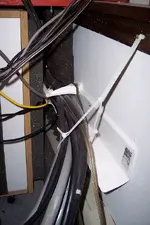dverno
Average Member
Hi everyone,
I'm a bit new here. This is the first time I've started a thread. I've looked through this forum and haven't found anything on the subject of cable routing. Am I perhaps missing it in another forum?. If not, then I'm looking for suggestions on how to best organize my more permanently placed cabling. I've been looking at plastic wire "looms" (or also called “raceways"), kind of a 'U' shaped channel with openings along both vertical walls and a removable cap piece. These look like they would work for me, but I'm interested in how others are organizing their wires. Also, the looms I'm talking about are kind of expensive, and I'm wondering if there is a cheaper alternative. I've never seen anybody talk about this, but since we all have wires to deal with and some of them stay hooked up for long periods, I assume this is a subject that could benefit everyone. Hopefully, I'm just a late-comer and there is some standard system I've managed to miss. Any suggestions are welcome.
EDIT: Since seeing the replies I've gotten on this thread, I would like to suggest a slightly different question:
HOW DO OTHERS ON THIS SITE ACTUALLY RUN THEIR WIRES AND CABLES THROUGHOUT THEIR STUDIOS, AND WHY DO THEY USE THAT METHOD?
I'm a bit new here. This is the first time I've started a thread. I've looked through this forum and haven't found anything on the subject of cable routing. Am I perhaps missing it in another forum?. If not, then I'm looking for suggestions on how to best organize my more permanently placed cabling. I've been looking at plastic wire "looms" (or also called “raceways"), kind of a 'U' shaped channel with openings along both vertical walls and a removable cap piece. These look like they would work for me, but I'm interested in how others are organizing their wires. Also, the looms I'm talking about are kind of expensive, and I'm wondering if there is a cheaper alternative. I've never seen anybody talk about this, but since we all have wires to deal with and some of them stay hooked up for long periods, I assume this is a subject that could benefit everyone. Hopefully, I'm just a late-comer and there is some standard system I've managed to miss. Any suggestions are welcome.
EDIT: Since seeing the replies I've gotten on this thread, I would like to suggest a slightly different question:
HOW DO OTHERS ON THIS SITE ACTUALLY RUN THEIR WIRES AND CABLES THROUGHOUT THEIR STUDIOS, AND WHY DO THEY USE THAT METHOD?
Last edited:


